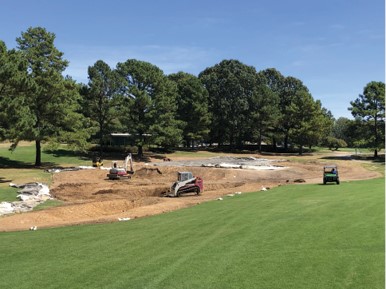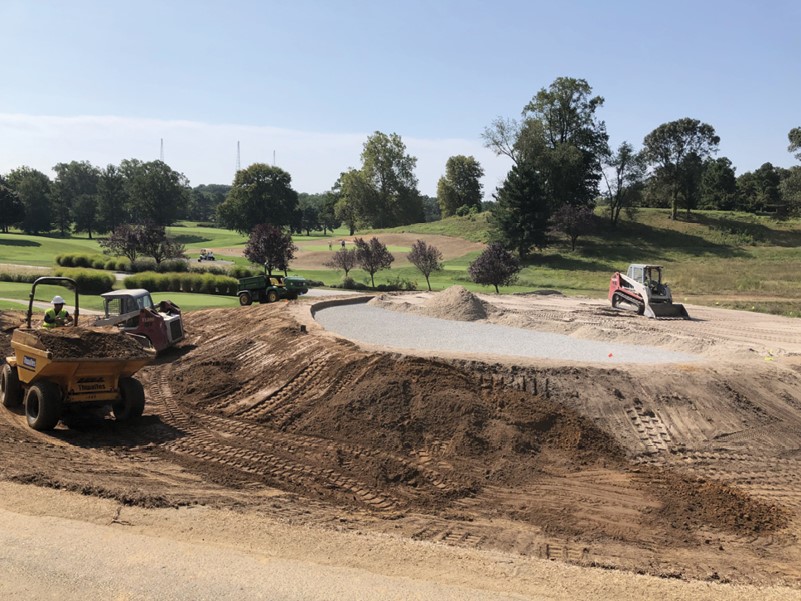
A visitor to the United States Naval Academy is immediately stirred by the sense of history that is discernable at every turn.
That same historical aura is in evidence at the United States Naval Academy Golf Club in Annapolis, Md., where superintendent Eric David is charged with overseeing a major renovation while at the same time helping preserve and enhance the work of one of the greatest architects of all time.
David, who has a two-year turf degree from Michigan State, was hired in June 2017 after a decade at Baltimore Country Club. He was well familiar with the planned renovation even before he arrived.
“My boss at Baltimore Country Club (Tim Kennelly) had worked here in the late ’80s and early ’90s,” David says, “and had always told me about what a special place this was. Although it might not be the big-name club, he had always said that it had a fantastic membership and great people to work with and be around, and when the job came open, the (word) had been going around that this golf course was going to be renovated.”
The first golf course on the property was completed in 1928, the work of Chicago architect Harry Collis. At the time, the site was home to the Greenbury Point Yacht and Country Club. The club collapsed during the Great Depression, but the Navy purchased the site in 1938, in part for the purpose of constructing radio towers.

Nine holes reopened in 1940 before legendary architect William Flynn arrived on site in 1942. Over the next two years, he would revise some of Collis’s work and design additional holes. Flynn’s 18-hole course opened for play on May 1, 1944. It was the last course he designed; kidney disease took his life the following January at age 53.
The renovation will seek to both restore and enhance Flynn’s work. All 18 greens will be rebuilt to conform to present-day USGA standards and restore as much of Flynn’s original unique shapes, many of which have been lost over the course of time. The bunkers will be rebuilt and, in some cases, repositioned.
Finally, the entire course will be regrassed.
If all goes well, and the weather cooperates, the project will be completed sometime in late summer 2020.
Work commenced Aug. 5, but David and his team of 15 began their preparations well in advance of that date. Tree removal was – and remains – a priority along with removing unwanted strains of grass.
The property features an abundance of turf species, including bent/Poa annua greens, along with Baymont Bermudagrass fairways and mostly Bermudagrass tees, save for those in shaded areas where ryegrass is prevalent. The rough features cool-season grasses, ryegrass, fescue and bluegrass, along with zoysiagrass bunker banks.
David’s experiences at Baltimore Country Club taught him about caring for multiple turf species simultaneously.
“A lot of my program has come from taking what I already know,” he says, “and trying to tweak it to fit the grass and the soil types we have on this property.
“I rotate through most of the fungicides that are on the market for summer patch, dollar spot, Pythium, Pythium root rot, brown patch. I use quite a few different products in order to target different issues at different times of the year.”
Prior to the start of the renovation, David and his team focused considerable attention on the green collars. “We have a lot of Bermudagrass contamination in the green surrounds,” he says, “so we’re trying to remove as much Bermudagrass as possible.”
David also made sure all the necessary equipment was on hand. “We were really focusing on having all the equipment and the pieces that we need to use for taking care of brand-new grass,” he says, “and trying to teach the crew how to properly use the equipment. When you get to the very new grass, I think there’s going to be quite a bit of a learning curve for all of us as we get moving along, but I have full confidence that we’ll be able to take care of everything.”
Andrew Green is the architect in charge of the project. Based in Baltimore, the Virginia Tech graduate spent 14 years at McDonald & Sons and started work on a master plan for the Naval Academy course more than 15 years ago. When he was out on his own in 2014, the USNA project went with him.
Green is a restoration specialist, with a resume that includes Inverness in Toledo, the site of the 2021 Solheim Cup. He’s currently working on the East Course at Oak Hill Country Club in Rochester, N.Y., site of the 2023 PGA Championship. For the USNA project, he reunited with McDonald & Sons, which is handling the construction aspects of the project.
An admitted history buff, Green is a fan of the Golden Age of golf course architecture, particularly the Philadelphia School of design, which boasts William Flynn as its most prominent member. Green says, “The passion and thought, the way the architects of that tine were communicating and trying to one up each other or utilize these great pieces of property to create wonderful golf and strategy. How can you not fall in love with what that era brought?”
Green strives to take Golden Age design concepts and adapt them to golf’s modern era. “That’s where I find my energy and passion, “taking those great ideas and making sure they work because the game has changed so much that just tying those two pieces together is a lot of fun,” he says.
Some would debate whether the Naval Academy project is a renovation or a restoration, but Green’s efforts, however they are categorized, are intended to restore as much of Flynn’s work as possible, while making allowances for 21st-century realities.
“With this project, the greens will go back as close as we can get them to original shapes, sizes and contours.” Green says. “Some of the green contours will have to be softened because of modern green speeds. But for the most part, the greens will be put back to their original condition.”
David adds the new greens will be built to withstand the warm, humid conditions that are common in the area during much of the golf season.
“Pushup greens tend to get wet and stay wet,” David says. “We have thunderstorms in the Mid-Atlantic all the time. The reason for going to the sand-based greens is just that. If we were to get a thunderstorm, a couple inches of rain, and the sun comes out and the heat and humidity go back up in the ’90s, we would lose the (pushup) greens.”
Bunkering is a key factor in any renovation effort. A number of Flynn’s bunkers have disappeared from the Naval Academy layout over time. Others no longer affect play due to advances in equipment technology. And some greenside bunkers are farther from the greens than they were when they were built because the putting surfaces decreased in size. The project will include outfitting the bunkers with new sand and concrete liners.
“In terms of their positions, depth, sizes, and things; we’ll try to follow Flynn’s plan as best we can in that regard,” Green says. “It’s really the fairway bunkers and maybe some tee placements that will be adjusted for the modern game and the distance of the long player.”
The layout at the Naval Academy has changed relatively little since Flynn finished his work. Fifteen of his original holes and part of a 16th remain, although the routing has changed somewhat over the past 75 years.
The most significant changes occurred at what are now holes 12 through 14, which were reworked around 1954 or ’55, possibly by Bob Williams, the club’s golf professional at the time, because the Navy wanted to construct a building in that location.

When Green’s work is complete, the 12th hole, now a short par 4, will be a long, reverse Redan par 3. The 13th, now a par 4, will become a double-dogleg par 5, while the 14th, now a short par 5, will become a long par 4. “Those holes will add to the variety for all the players on the back nine,” Green says, “and try to pay more homage to Flynn.”
The renovation commenced with the closing of the back nine. Work on the inward nine’s greens and the bunkers should continue until October, when the back nine will reopen, albeit with temporary greens. At that point, work will begin on the front nine along with perhaps fine-tuning some fairway bunkers.
By early December, the course will be shut down for the winter. It will reopen in early May for member play for approximately six weeks before it is shut down again for the summer while the tees and fairways are converted to Tahoma 31 Bermudagrass, which was developed at Oklahoma State University and has been shown to be resistant to drought conditions and cold weather, both of which are causes for concern in the Mid-Atlantic.
David’s goal is to have the fully renovated golf course reopened for good by next August or September. But if it takes longer to do the job right, so be it. This renovation, after all, will shape the future of the club for decades to come.
“This renovation is for the next 50 years,” David says. “I don’t see this golf course being renovated again any time soon, so the big thing for us is making sure we get it right, that we nail it exactly the way it needs to be done.”
David notes the club’s members have been extremely supportive of the renovation effort. “Many of them have been members for 30 to 40 years, and it’s almost like when they get it back, they get a whole new golf course,” he says. “New cupping locations, new grass, different ways to play the golf course.
“Still maintaining the Flynn course and the greens the way they were originally designed but really, again, going back to how it was built in the 1940s.”

Explore the October 2019 Issue
Check out more from this issue and find your next story to read.
Latest from Golf Course Industry
- Audubon International announces newest leadership appointees
- Southern golf trifecta
- Sports for Nature Framework gains new signatories
- Camiral Golf & Wellness upgrades Stadium Course
- Troon selected to manage The University Club of Milwaukee
- Kafka Granite adds new business development manager
- GCSAA celebrates 10-year anniversary of collaboration with Congress
- DLF launches new seed enhancement solution





